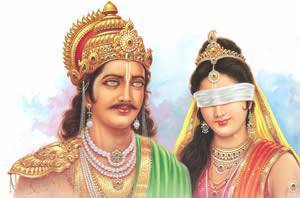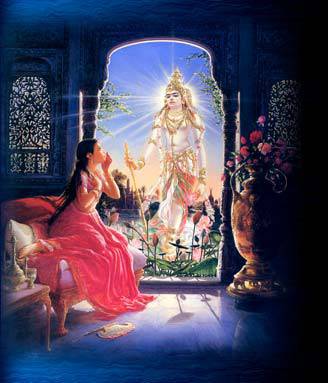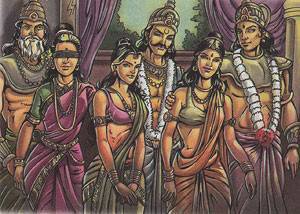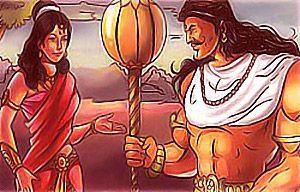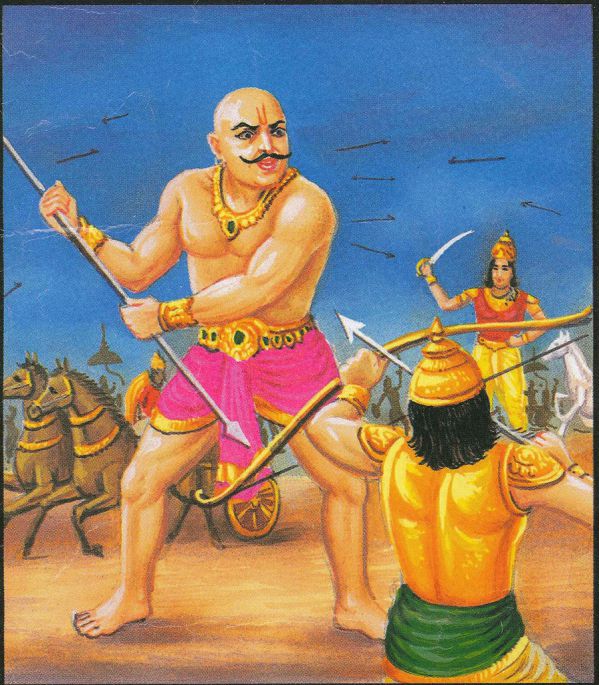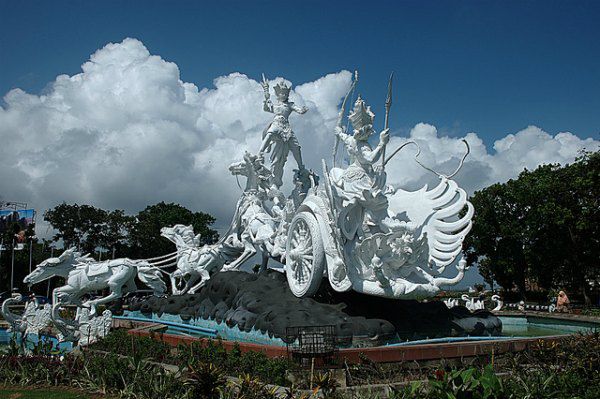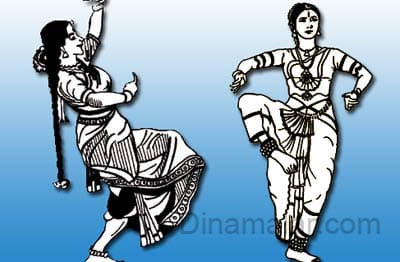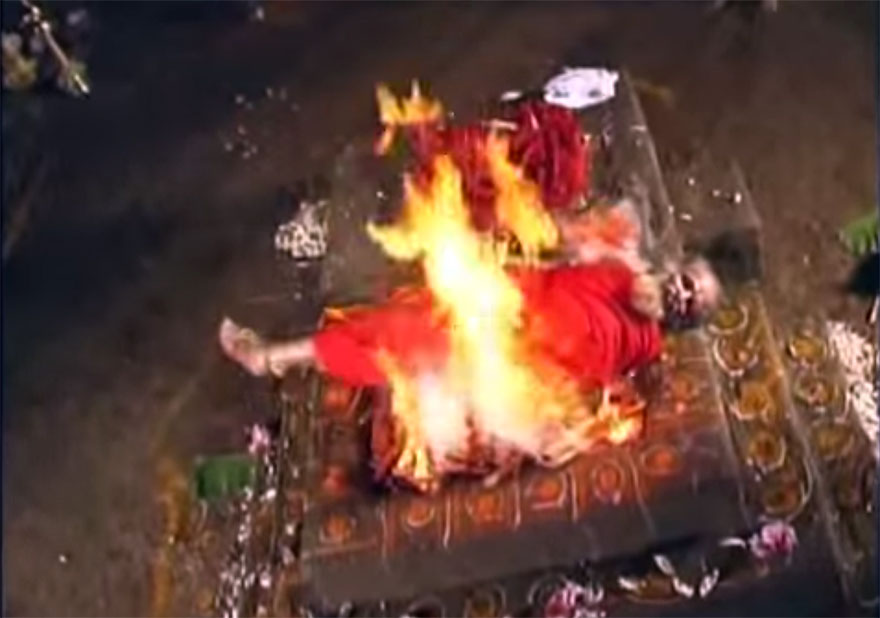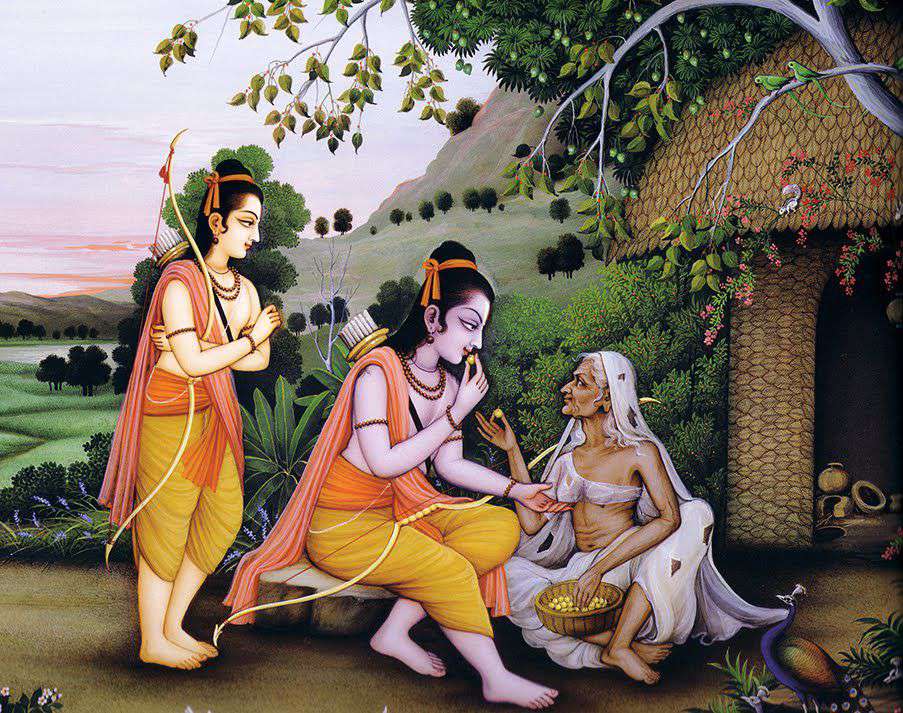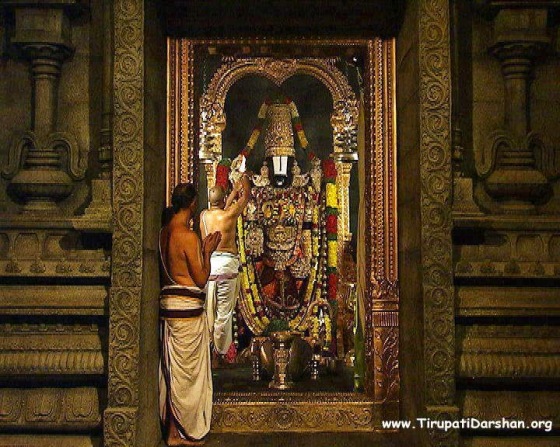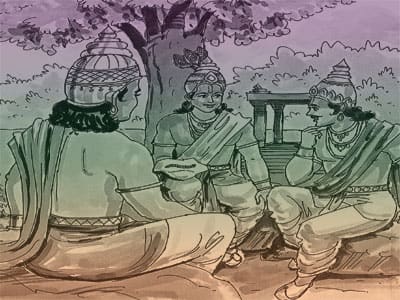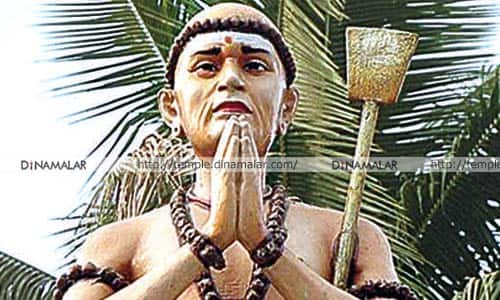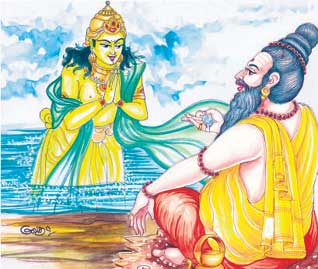P.J.
0
தெய்வம் யாவரும் வணங்கும் தெய்வம்
தெய்வம் யாவரும் வணங்கும் தெய்வம்
செப்டம்பர் 28,2013

ஆதிமுதல்வன் என்று போற்றப்படுபவர் பிரணவ வடிவினரான விநாயகப் பெருமான். இல்லாத இடமில்லை என்று சொல்லும்வண்ணம், எங்கெங்கும் கோவில் கொண்டுள்ளவர் அவர். அவரது சில திருத்தலங்கள்..
தமிழகத்திலேயே மலை உச்சியில் தனக்கென தனிக்கோவில் கொண்டு அருள்புரிபவர் திருச்சி மலைக்கோட்டையிலுள்ள உச்சிப்பிள்ளையார். ஸ்ரீராமபிரான், இலங்கைப் போரில் தனக்கு உதவிபுரிந்த விபீஷணனுக்கு ஸ்ரீரங்கநாதர் விக்ரகத்தைப் பரிசளித்தார். அதை தரையில் வைக்கக்கூடாதென்றும் அறிவுறுத்தினார். விபீஷணன் அந்த விக்ரகத்துடன் இலங்கை நோக்கிச் செல்லும்போது திருச்சி பகுதிக்கு வந்தான். காவேரியில் நீராடி தன் அன்றாடக் கடமைகளைச் செய்ய எண்ணினான் அவன். ஆனால் விக்ரகத்தைக் கீழே வைக்கக்கூடாதே. என்ன செய்வதென்று அவன் யோசித்தபோது அங்கு விநாயகர் ஒரு சிறுவன் வடிவில் தோன்றினார். சிறுவனைக் கண்டு மகிழ்ந்த விபீஷணன், விக்ரகத்தை சற்றுநேரம் வைத்திருக்குமாறு கூறிவிட்டு நீராடச் சென்றான். சிறிது நேரம் பொறுத்திருந்த விநாயகர் விக்ரகத்தைக் கீழே வைத்துவிட்டார். திரும்பிவந்த விபீஷணன் விக்ரகம் தரையில் இருப்பதைக்கண்டு அதிர்ச்சியடைந்து, அதைப் பெயர்த்தெடுக்க எவ்வளவோ முயன்றான். ஆனால் முடியவில்லை. இப்படி, உச்சிப்பிள்ளையாரின் திருவிளையாடலால் அமைந்ததுதான் ஸ்ரீரங்கம் திருக்கோவில்.
காரைக்குடி அருகிலுள்ள பிள்ளையார்பட்டி திருத்தல விநாயகர் வித்தியாசமானவர். அவர் குடைவரைக் கோவிலில் எழுந்தருளியுள்ளார். அதாவது பாறையைக் குடைந்து வடிக்கப்பெற்ற உருவம். சுமார் 1,500 ஆண்டுகளுக்கு முற்பட்ட இந்தப் பிள்ளையாருக்கு இரண்டு கைகள் மட்டுமே உள்ளன. வலது திருக்கரத்தில் சிறிய லிங்கத்திருமேனியை வைத்துள்ளார். இடக்கரம் தொந்தியைச் சுற்றியுள்ள கச்சைமீது உள்ளது. வலம்புரி விநாயகரான இவரைச் சுற்றி ஒன்பது சரவிளக்குகள் தொங்குகின்றன. இந்த ஒன்பது விளக்குகளும் நவகிரகங்களைக் குறிப்பதாகச் சொல்கிறார்கள். இவர் இங்கு மூஷிக வாகனம் கொண்டு விளங்கவில்லை. இடப்பக்கம் பெண் யானையைப்போல் தந்தம் குறுகியும், வலப்பக்கம் ஆண் யானையைப்போல் தந்தம் நீண்டும் ஆண் பாதி-பெண் பாதி என்னும் தத்துவத்தை உணர்த்தும் வகையில் பேதங்களைக் கடந்தவராகக் காட்சி தருகிறார்.
ஆசியாவிலேயே பெரிய விநாயகர் கோவை புலியங்குளம் திருத்தலத்தில் அருள்புரிகிறார். 19 அடி, 10 அங்குலம் உயரமும்; 11 அடி 10 அங்குலம் அகலமும்; 190 டன் எடையும் கொண்டு ஒரே கல்லில் அமைக்கப்பெற்றவர். வலப்புறம் ஆண்தோற்றமும், இடப்புறம் பெண் தோற்றமும் கொண்டுள்ளார். மாதம்தோறும் சங்கடஹரசதுர்த்தி மற்றும் சித்திரை முதல் தேதியில், பத்து டன் எடையுள்ள பழங்களைக்கொண்டு மாலை அணிவித்து அலங்கரிப்பர்.
திருவையாறு ஐயாறப்பர் கோவிலிலும், திருச்சி பாலக்கரைப் பகுதியிலும், மதுரை ஸ்ரீமீனாட்சி அம்மன் ஆலயத்திலும், திருச்சி உத்தமர் கோவிலிலும், ஊட்டி பேருந்து நிலையம் அருகிலும், மயிலாடுதுறை அருகிலுள்ள திருவேள்விக்குடியிலும், கொல்லிமலை கொல்லிப்பாவைக் கோவிலுக்குச் செல்லும் வழியிலும் மற்றும் சில கோவில்களிலும் ஒரே சந்நிதியில் இரட்டைப் பிள்ளையார்கள் அருள்புரிவதைக் காணலாம். இவர்களை தரிசித்தால் இரட்டைப் பலன்கள் கிட்டும் என்பர். மேலும் துவிமுக கணபதி என்ற பெயரில் இரண்டு தலைகளையுடைய விநாயகரை சில கோவில்களின் கோபுரத்தில் கதை வடிவில் காணலாம்.
மூன்று விநாயகர்கள் ஒரே சந்நிதியில் அமர்ந்து அருள்புரிவதை திருச்சிக்கு அருகிலுள்ள சமயபுரம் கோவிலில் தரிசிக்கலாம். இத்திருக்கோவிலில் அருள்புரியும் மாரியம்மன் ஆரம்பகாலத்தில் கோரைப்பற்கள் தெரிய, சிவந்த கண்களுடன் மிகவும் உக்கிரமாக இருந்தாள். அவள் உக்கிரகத்தைக் குறைக்க காஞ்சி மாமுனிவர் யோசனைப்படி, ஆலய நுழைவாயிலின் வலப்புறத்தில் ஒரே சந்நிதியில் ஞானசக்தி, இச்சா சக்தி, கிரியா சக்தி என்ற மூன்று விநாயகர்களை எழுந்தருளச் செய்தனர். பின்னர் அம்மனின் கோரைப்பற்கள் அகற்றப்பட்டு சாந்தசொரூபியாக புதிய தோற்றம் கொண்டாள். 1970-ஆம் ஆண்டு புதிய திருவுருவை பிரதிஷ்டை செய்து கும்பாபிஷேகம் நடத்தப்பட்டது. இங்குள்ள மூன்று விநாயகர்களை தரிசிப்பதால் குடும்பத்தில் மகிழ்ச்சி, சாந்தம், வளமான வாழ்வு கிட்டும் என்பர். இதேபோல் மூன்று விநாயகர்கள் ஒரே சந்நிதியில் எழுந்தருளியிருப்பதை திருப்பரங்குன்றம் முருகன் கோவிலிலும் தரிசிக்கலாம்.
நான்கு தலைகள் கொண்ட விநாயகரை துவிஜ கணபதி என்பர். இவர் தன் கரங்களில் மின்னல் கொடிபோன்று ஒளிவீசக்கூடிய வளையல்கள் அணிந்தவர்; சந்திரன் போன்ற நிறமுடையவர்; புத்தகம், ஜெபமாலை, தண்டம், கமண்டலம் ஏந்தியவர் என்று விநாயக புராணம் கூறுகிறது.
ஒரே சந்நிதியில் ஐந்து விநாயகர்கள் வரிசையாக அமர்ந்து அருள்புரியும் திருத்தலம் அறந்தாங்கி ஆவுடையார் கோவிலிலிருந்து சுமார் 25 கிலோமீட்டர் தூரத்திலுள்ள திருப்புனவாசலிலும் இதுபோல தரிசிக்கலாம். ஆந்திர மாநிலம், ரேணிகுண்டாவிற்கு அருகிலுள்ள பஞ்சமுக விநாயகர் கோவிலில் ஒரே பீடத்தில் தனித்தனியாக ஐந்து பிள்ளையார்கள் வரிசையாகக் காட்சி தருகின்றனர்.
வரிசையாக ஆறு விநாயகர்கள் எழுந்தருளியிருப்பதை தஞ்சைக்கு அருகிலுள்ள திருக்கண்டியூர் சிவாலயத்தில் காணலாம்.
ஒரே சந்நிதியில் ஏழு விநாயகர்கள் வரிசையாக அருள்புரிவதை நெய்வேலி சிவாலயத்தில் தரிசிக்கலாம். இதேபோல் திருச்சிக்கு அருகிலுள்ள லால்குடி திருத்தலத்திலுள்ள ஸ்ரீசப்தகிரீஸ்வரர் கோவிலிலும் காணலாம்.
ஒரே சந்நிதியில் ஒன்பது விநாயகர்கள் அருள் புரியும் திருத்திலம், திருவெண்காடு அருகே அமைந்துள்ள திருநாங்கூர் ஆகும்.
வடஆற்காடு மாவட்டம், சேண்பாக்கத்தில் அமைந்துள்ள ஸ்ரீசெல்வ விநாயகர் ஆலயத்தில் பதினோரு விநாயகர்களை தரிசிக்கலாம். இந்த பதினோரு விநாயகர்கள் லிங்க வடிவில் காட்சி தருகிறார்கள். மேலும் திருவள்ளூர் அருகிலுள்ள திருப்பாசூர் சிவாலயத்திலும் பதினோரு விநாயகர்கள் ஒரே சந்நிதியில் காட்சி தருகிறார்கள்.
ராமேஸ்வரம் ஸ்ரீசங்கரமட வளாகத்திலுள்ள ஒரு தூண்பீடத்தில் பதினாறுவிதமான விநாயகரின் திருவுருவங்கள் பொறிக்கப்பட்டுள்ளன.
திருச்சி மலைக்கோட்டை நுறைவாயிலுள்ள ஸ்ரீமாணிக்க விநாயகர் சந்நிதியை வலம் வரும்போது, விமான மண்டபத்தைச் சுற்றி ஒரு பக்கத்திற்கு எட்டு விநாயகர்கள் வீதம் நான்கு பக்கங்களில் முப்பத்திரண்டு விநாயகர்கள் சுதை வடிவில் காட்சி தருகிறார்கள்.
திருவாரூர் ஸ்ரீதியாகராஜர் கோவிலில், வாதாபி கணபதியைச் சேர்த்து 56 கணபதிகள் உள்ளனர்.
109 விநாயகர்கள் ஒரே இடத்தில் வரிசையாக அருள்புரியும் திருத்தலங்கள் தமிழகத்தில் ஒருசில இடங்களில் உள்ளன. அந்த வகையில், திண்டுக்கல் நகரின் மத்தியில் கோபாலசமுத்திரம் குளக்கரையில் அமைந்துள்ள விநாயகர் கோவிலில்,108 விநாயகர்கள் எட்டு அடுக்குகளில் எழுந்தருளியுள்ளார்கள். இக்கோவிலில், மூலஸ்தானத்தில் எழுந்தருளியிருக்கும் விநாயகர் சுமார் 16அடி உயரத்தில் விஸ்வரூபத்தில் அருள்புரிகிறார். இதேபோல் காரைக்குடியிலிருந்து வயிரவன் சிவன் கோவிலில் 108 விநாயகர்கள் எழுந்தருளியுள்ளனர்.
ஒரே சந்நிதியில் 108 விநாயகர்கள் அருள்புரியும் திருத்தலம் கோவை பந்தயசாலை (ரேஸ்கோர்ஸ்) பகுதியிலுள்ள ஸ்ரீசெல்வவிநாயகர் ஆலயம். இங்கு ஸ்ரீசக்கர விடிவில் 108 விநாயகர் சிலைகள் உள்ளன. இவையனைத்தும் 108 நாம வழிபாட்டின் பிரதிஷ்டை செய்யப்பட்டுள்ளன. இந்த 108 விநாயகர்களும் உருவத்தில் வேறுபாடு கொண்டவர்கள் என்பது தனிச்சிறப்பாகும்.
விநாயகர் யானை முகத்துடன் பெரும்பாலான கோவில்களில் அருள்புரிவதைப்போல், மனித முகம்கொண்ட ஆதி விநாயகர் நாகை மாவட்டம் செதலபுரி திருத்திலத்தில் அருள்புரிகிறார். இதேபோல் தாராபுரம் தில்லாபுரி அம்மன் கோவிலிலும், திருச்சி துறையூருக்கு அருகிலுள்ள புளியஞ்சோலை என்னுமிடத்திலும் நரமுக கணபதியை தரிசிக்கலாம். கோவை, குனியமுத்தூர் கோவிலில் சபரிமலை ஐயப்பனைப்போல் யோக பட்டம் தரித்து, இளஞ்சூரிய நிறத்தோடு, யோக நிஷ்டையில் அமர்ந்துள்ளார் விநாயகர். இடது முன்கையில் அட்சமாலையும், பின்கையில் கரும்பும்; இடது முன்கையில் யோகதண்டமும், பின்கையில் பாசக்கயிறும் ஏந்தி கிழக்கு நோக்கியுள்ளார். இவர் பக்தர்களுக்கு அஷ்ட யோகங்களையும் வழங்குவதாக ஐதீகம்.
விநாயகரின் வாகனம் மூஷிகம் என்று சொல்லப்பட்டாலும் பல்வேறு யுகங்களில் வெவ்வேறு வாகனத்தில் அருள்புரிந்திருக்கிறார்.
கிருதயுகத்தில் விநாயகரின் வாகனம் சிங்கம்; திரேதாயுகத்தில் மயில்; துவாபரயுகத்தில் மூஷிகம்; கலியுகத்தில் இவரது வாகனம் குதிரை என்று சொல்லப்பட்டாலும் அந்த வாகனத்துடன் தரிசிப்பது அரிது.
நாகை நீலாயதாட்சி ஆலயத்தில் பஞ்சமுகங்களுடன் காணப்படும் விநாயகர் சிம்ம வாகனத்துடன் காட்சி தருகிறார். இதே போல் சென்னை திருவெற்றியூர் குரு தட்சிணாமூர்த்தி ஆலயத்திலும் பஞ்சமுகங்களுடன் சிங்கத்தில் அமர்ந்துள்ளார்.
புதுச்சேரி மணக்குள விநாயகர் ஆலய சுதைச் சிற்பத்திலும், அருப்புக்கோட்டை தாதன்குள விநாயகர் ஆலயத்திலும், திருவானைக்கா ஸ்ரீஅகிலாண்டேஸ்வரி கோவிலிலுள்ள ஒவியத்திலும் விநாயகர் மயில் வாகனத்துடன் காட்சி தருகிறார்.
கோவை குரூபதேசீகக் கவுண்டர் ஆலயத்திலும், கடலூர் வட்டம், சென்னப்ப நாயகரகன் பாளையத்திலும், மலையாண்டவர் விநாயகர் ஆலயத்திலும் குதிரை வாகனத்தில் காட்சி தருவதைக் காணலாம். திருச்செந்தூர் ஆவுடையார் குளக்கரையில், வைத்திய நாதசுவாமி ஆலயத்திலுள்ள விநாயகருக்கு யானை வாகனமாக உள்ளது.
சுசீந்திரம் தாணுமாலயன் ஆலய விநாயகருக்கு வாகனமாக காளை உள்ளது. இதேபோல் நெல்லை காந்திமதியம்மன் கோவில் விநாயகர் முன்பும் காளை வாகனம் காட்சியளிக்கிறது.
இந்தோனேஷியா நாட்டில் விநாயகரின் வாகனம் ஆமை.
பொதுவாக, விநாயகர் திருவுருவில் நான்கு கரங்கள் இருக்கும். சில கோவில்களில் மாறுபட்டிருப்பதையும் தரிசிக்கலாம்.
ஒரு கரம், தும்பிக்கை கொண்டவர் மதுரை, மாத்தங்கரையிலுள்ள கோடாரி விநாயகர் ஆவார்.
இரண்டு கரங்களுடன் விநாயகரை பிள்ளையார்பட்டியில் தரிசிக்கலாம்.
சீனாவில் மூன்று கரங்களுடன் விநாயகர் காட்சி தருகிறார். நான்கு கரங்கள் கொண்ட விநாயகரை பல திருக்கோவில்களில் தரிசிக்கலாம்.
ஆறு கைகள் கொண்ட கணபதி மும்பையில் அருள்புரிகிறார்.
திருச்செந்தூரில் ஏழு கரங்களுடன் காட்சி தரும் விநாயகரை உச்சிஷ்ட கணபதி என்பர்.
நான்கு முகங்கள், எட்டு கைகளுடன் கணபதி சீனநாட்டில் அருள்புரிகிறார்.
ஒன்பது கரங்கள் கொண்ட கணபதியை தருண கணபதி என்பர். சில கோவில் கோபுரங்களில் காணலாம்.
பத்துக் கரங்கள் கொண்ட பஞ்சமுக கணபதியை சேலம் கந்தாஸ்ரமத்திலும், குச்சனூர் திருத்தலத்திலும் தரிசிக்கலாம்.
பதினோரு கரங்களுடைய கணபதி கொல்லூர் மூகாம்பிகை கோவிலில் எழுந்தருளியுள்ளார்.
பதினைந்து கரங்கள் கொண்ட ஹேரம்ப கணபதி மும்பையில் பல இடங்களில் கோவில் கொண்டுள்ளார்.
பதினெழு கரங்கள் கொண்ட கணபதியை வீரகணபதி என்பர். பதினெட்டு கரங்கள் கொண்ட கணபதியை தமிழகத்தில் சில கோவில் விமானங்களில் காணலாம்.
விநாயகப் பெருமான் எந்தவிதமான தோற்றத்தில் காட்சி தந்தாலும் பக்தர்கள் கேட்கும் பிரார்த்தனையை நிறைவேற்றி மகிழ்ச்சியை வழங்குவதில் வல்லவர் என்பதில் ஐயமில்லை
http://temple.dinamalar.com/news_detail.php?id=22711
தெய்வம் யாவரும் வணங்கும் தெய்வம்
செப்டம்பர் 28,2013

ஆதிமுதல்வன் என்று போற்றப்படுபவர் பிரணவ வடிவினரான விநாயகப் பெருமான். இல்லாத இடமில்லை என்று சொல்லும்வண்ணம், எங்கெங்கும் கோவில் கொண்டுள்ளவர் அவர். அவரது சில திருத்தலங்கள்..
தமிழகத்திலேயே மலை உச்சியில் தனக்கென தனிக்கோவில் கொண்டு அருள்புரிபவர் திருச்சி மலைக்கோட்டையிலுள்ள உச்சிப்பிள்ளையார். ஸ்ரீராமபிரான், இலங்கைப் போரில் தனக்கு உதவிபுரிந்த விபீஷணனுக்கு ஸ்ரீரங்கநாதர் விக்ரகத்தைப் பரிசளித்தார். அதை தரையில் வைக்கக்கூடாதென்றும் அறிவுறுத்தினார். விபீஷணன் அந்த விக்ரகத்துடன் இலங்கை நோக்கிச் செல்லும்போது திருச்சி பகுதிக்கு வந்தான். காவேரியில் நீராடி தன் அன்றாடக் கடமைகளைச் செய்ய எண்ணினான் அவன். ஆனால் விக்ரகத்தைக் கீழே வைக்கக்கூடாதே. என்ன செய்வதென்று அவன் யோசித்தபோது அங்கு விநாயகர் ஒரு சிறுவன் வடிவில் தோன்றினார். சிறுவனைக் கண்டு மகிழ்ந்த விபீஷணன், விக்ரகத்தை சற்றுநேரம் வைத்திருக்குமாறு கூறிவிட்டு நீராடச் சென்றான். சிறிது நேரம் பொறுத்திருந்த விநாயகர் விக்ரகத்தைக் கீழே வைத்துவிட்டார். திரும்பிவந்த விபீஷணன் விக்ரகம் தரையில் இருப்பதைக்கண்டு அதிர்ச்சியடைந்து, அதைப் பெயர்த்தெடுக்க எவ்வளவோ முயன்றான். ஆனால் முடியவில்லை. இப்படி, உச்சிப்பிள்ளையாரின் திருவிளையாடலால் அமைந்ததுதான் ஸ்ரீரங்கம் திருக்கோவில்.
காரைக்குடி அருகிலுள்ள பிள்ளையார்பட்டி திருத்தல விநாயகர் வித்தியாசமானவர். அவர் குடைவரைக் கோவிலில் எழுந்தருளியுள்ளார். அதாவது பாறையைக் குடைந்து வடிக்கப்பெற்ற உருவம். சுமார் 1,500 ஆண்டுகளுக்கு முற்பட்ட இந்தப் பிள்ளையாருக்கு இரண்டு கைகள் மட்டுமே உள்ளன. வலது திருக்கரத்தில் சிறிய லிங்கத்திருமேனியை வைத்துள்ளார். இடக்கரம் தொந்தியைச் சுற்றியுள்ள கச்சைமீது உள்ளது. வலம்புரி விநாயகரான இவரைச் சுற்றி ஒன்பது சரவிளக்குகள் தொங்குகின்றன. இந்த ஒன்பது விளக்குகளும் நவகிரகங்களைக் குறிப்பதாகச் சொல்கிறார்கள். இவர் இங்கு மூஷிக வாகனம் கொண்டு விளங்கவில்லை. இடப்பக்கம் பெண் யானையைப்போல் தந்தம் குறுகியும், வலப்பக்கம் ஆண் யானையைப்போல் தந்தம் நீண்டும் ஆண் பாதி-பெண் பாதி என்னும் தத்துவத்தை உணர்த்தும் வகையில் பேதங்களைக் கடந்தவராகக் காட்சி தருகிறார்.
ஆசியாவிலேயே பெரிய விநாயகர் கோவை புலியங்குளம் திருத்தலத்தில் அருள்புரிகிறார். 19 அடி, 10 அங்குலம் உயரமும்; 11 அடி 10 அங்குலம் அகலமும்; 190 டன் எடையும் கொண்டு ஒரே கல்லில் அமைக்கப்பெற்றவர். வலப்புறம் ஆண்தோற்றமும், இடப்புறம் பெண் தோற்றமும் கொண்டுள்ளார். மாதம்தோறும் சங்கடஹரசதுர்த்தி மற்றும் சித்திரை முதல் தேதியில், பத்து டன் எடையுள்ள பழங்களைக்கொண்டு மாலை அணிவித்து அலங்கரிப்பர்.
திருவையாறு ஐயாறப்பர் கோவிலிலும், திருச்சி பாலக்கரைப் பகுதியிலும், மதுரை ஸ்ரீமீனாட்சி அம்மன் ஆலயத்திலும், திருச்சி உத்தமர் கோவிலிலும், ஊட்டி பேருந்து நிலையம் அருகிலும், மயிலாடுதுறை அருகிலுள்ள திருவேள்விக்குடியிலும், கொல்லிமலை கொல்லிப்பாவைக் கோவிலுக்குச் செல்லும் வழியிலும் மற்றும் சில கோவில்களிலும் ஒரே சந்நிதியில் இரட்டைப் பிள்ளையார்கள் அருள்புரிவதைக் காணலாம். இவர்களை தரிசித்தால் இரட்டைப் பலன்கள் கிட்டும் என்பர். மேலும் துவிமுக கணபதி என்ற பெயரில் இரண்டு தலைகளையுடைய விநாயகரை சில கோவில்களின் கோபுரத்தில் கதை வடிவில் காணலாம்.
மூன்று விநாயகர்கள் ஒரே சந்நிதியில் அமர்ந்து அருள்புரிவதை திருச்சிக்கு அருகிலுள்ள சமயபுரம் கோவிலில் தரிசிக்கலாம். இத்திருக்கோவிலில் அருள்புரியும் மாரியம்மன் ஆரம்பகாலத்தில் கோரைப்பற்கள் தெரிய, சிவந்த கண்களுடன் மிகவும் உக்கிரமாக இருந்தாள். அவள் உக்கிரகத்தைக் குறைக்க காஞ்சி மாமுனிவர் யோசனைப்படி, ஆலய நுழைவாயிலின் வலப்புறத்தில் ஒரே சந்நிதியில் ஞானசக்தி, இச்சா சக்தி, கிரியா சக்தி என்ற மூன்று விநாயகர்களை எழுந்தருளச் செய்தனர். பின்னர் அம்மனின் கோரைப்பற்கள் அகற்றப்பட்டு சாந்தசொரூபியாக புதிய தோற்றம் கொண்டாள். 1970-ஆம் ஆண்டு புதிய திருவுருவை பிரதிஷ்டை செய்து கும்பாபிஷேகம் நடத்தப்பட்டது. இங்குள்ள மூன்று விநாயகர்களை தரிசிப்பதால் குடும்பத்தில் மகிழ்ச்சி, சாந்தம், வளமான வாழ்வு கிட்டும் என்பர். இதேபோல் மூன்று விநாயகர்கள் ஒரே சந்நிதியில் எழுந்தருளியிருப்பதை திருப்பரங்குன்றம் முருகன் கோவிலிலும் தரிசிக்கலாம்.
நான்கு தலைகள் கொண்ட விநாயகரை துவிஜ கணபதி என்பர். இவர் தன் கரங்களில் மின்னல் கொடிபோன்று ஒளிவீசக்கூடிய வளையல்கள் அணிந்தவர்; சந்திரன் போன்ற நிறமுடையவர்; புத்தகம், ஜெபமாலை, தண்டம், கமண்டலம் ஏந்தியவர் என்று விநாயக புராணம் கூறுகிறது.
ஒரே சந்நிதியில் ஐந்து விநாயகர்கள் வரிசையாக அமர்ந்து அருள்புரியும் திருத்தலம் அறந்தாங்கி ஆவுடையார் கோவிலிலிருந்து சுமார் 25 கிலோமீட்டர் தூரத்திலுள்ள திருப்புனவாசலிலும் இதுபோல தரிசிக்கலாம். ஆந்திர மாநிலம், ரேணிகுண்டாவிற்கு அருகிலுள்ள பஞ்சமுக விநாயகர் கோவிலில் ஒரே பீடத்தில் தனித்தனியாக ஐந்து பிள்ளையார்கள் வரிசையாகக் காட்சி தருகின்றனர்.
வரிசையாக ஆறு விநாயகர்கள் எழுந்தருளியிருப்பதை தஞ்சைக்கு அருகிலுள்ள திருக்கண்டியூர் சிவாலயத்தில் காணலாம்.
ஒரே சந்நிதியில் ஏழு விநாயகர்கள் வரிசையாக அருள்புரிவதை நெய்வேலி சிவாலயத்தில் தரிசிக்கலாம். இதேபோல் திருச்சிக்கு அருகிலுள்ள லால்குடி திருத்தலத்திலுள்ள ஸ்ரீசப்தகிரீஸ்வரர் கோவிலிலும் காணலாம்.
ஒரே சந்நிதியில் ஒன்பது விநாயகர்கள் அருள் புரியும் திருத்திலம், திருவெண்காடு அருகே அமைந்துள்ள திருநாங்கூர் ஆகும்.
வடஆற்காடு மாவட்டம், சேண்பாக்கத்தில் அமைந்துள்ள ஸ்ரீசெல்வ விநாயகர் ஆலயத்தில் பதினோரு விநாயகர்களை தரிசிக்கலாம். இந்த பதினோரு விநாயகர்கள் லிங்க வடிவில் காட்சி தருகிறார்கள். மேலும் திருவள்ளூர் அருகிலுள்ள திருப்பாசூர் சிவாலயத்திலும் பதினோரு விநாயகர்கள் ஒரே சந்நிதியில் காட்சி தருகிறார்கள்.
ராமேஸ்வரம் ஸ்ரீசங்கரமட வளாகத்திலுள்ள ஒரு தூண்பீடத்தில் பதினாறுவிதமான விநாயகரின் திருவுருவங்கள் பொறிக்கப்பட்டுள்ளன.
திருச்சி மலைக்கோட்டை நுறைவாயிலுள்ள ஸ்ரீமாணிக்க விநாயகர் சந்நிதியை வலம் வரும்போது, விமான மண்டபத்தைச் சுற்றி ஒரு பக்கத்திற்கு எட்டு விநாயகர்கள் வீதம் நான்கு பக்கங்களில் முப்பத்திரண்டு விநாயகர்கள் சுதை வடிவில் காட்சி தருகிறார்கள்.
திருவாரூர் ஸ்ரீதியாகராஜர் கோவிலில், வாதாபி கணபதியைச் சேர்த்து 56 கணபதிகள் உள்ளனர்.
109 விநாயகர்கள் ஒரே இடத்தில் வரிசையாக அருள்புரியும் திருத்தலங்கள் தமிழகத்தில் ஒருசில இடங்களில் உள்ளன. அந்த வகையில், திண்டுக்கல் நகரின் மத்தியில் கோபாலசமுத்திரம் குளக்கரையில் அமைந்துள்ள விநாயகர் கோவிலில்,108 விநாயகர்கள் எட்டு அடுக்குகளில் எழுந்தருளியுள்ளார்கள். இக்கோவிலில், மூலஸ்தானத்தில் எழுந்தருளியிருக்கும் விநாயகர் சுமார் 16அடி உயரத்தில் விஸ்வரூபத்தில் அருள்புரிகிறார். இதேபோல் காரைக்குடியிலிருந்து வயிரவன் சிவன் கோவிலில் 108 விநாயகர்கள் எழுந்தருளியுள்ளனர்.
ஒரே சந்நிதியில் 108 விநாயகர்கள் அருள்புரியும் திருத்தலம் கோவை பந்தயசாலை (ரேஸ்கோர்ஸ்) பகுதியிலுள்ள ஸ்ரீசெல்வவிநாயகர் ஆலயம். இங்கு ஸ்ரீசக்கர விடிவில் 108 விநாயகர் சிலைகள் உள்ளன. இவையனைத்தும் 108 நாம வழிபாட்டின் பிரதிஷ்டை செய்யப்பட்டுள்ளன. இந்த 108 விநாயகர்களும் உருவத்தில் வேறுபாடு கொண்டவர்கள் என்பது தனிச்சிறப்பாகும்.
விநாயகர் யானை முகத்துடன் பெரும்பாலான கோவில்களில் அருள்புரிவதைப்போல், மனித முகம்கொண்ட ஆதி விநாயகர் நாகை மாவட்டம் செதலபுரி திருத்திலத்தில் அருள்புரிகிறார். இதேபோல் தாராபுரம் தில்லாபுரி அம்மன் கோவிலிலும், திருச்சி துறையூருக்கு அருகிலுள்ள புளியஞ்சோலை என்னுமிடத்திலும் நரமுக கணபதியை தரிசிக்கலாம். கோவை, குனியமுத்தூர் கோவிலில் சபரிமலை ஐயப்பனைப்போல் யோக பட்டம் தரித்து, இளஞ்சூரிய நிறத்தோடு, யோக நிஷ்டையில் அமர்ந்துள்ளார் விநாயகர். இடது முன்கையில் அட்சமாலையும், பின்கையில் கரும்பும்; இடது முன்கையில் யோகதண்டமும், பின்கையில் பாசக்கயிறும் ஏந்தி கிழக்கு நோக்கியுள்ளார். இவர் பக்தர்களுக்கு அஷ்ட யோகங்களையும் வழங்குவதாக ஐதீகம்.
விநாயகரின் வாகனம் மூஷிகம் என்று சொல்லப்பட்டாலும் பல்வேறு யுகங்களில் வெவ்வேறு வாகனத்தில் அருள்புரிந்திருக்கிறார்.
கிருதயுகத்தில் விநாயகரின் வாகனம் சிங்கம்; திரேதாயுகத்தில் மயில்; துவாபரயுகத்தில் மூஷிகம்; கலியுகத்தில் இவரது வாகனம் குதிரை என்று சொல்லப்பட்டாலும் அந்த வாகனத்துடன் தரிசிப்பது அரிது.
நாகை நீலாயதாட்சி ஆலயத்தில் பஞ்சமுகங்களுடன் காணப்படும் விநாயகர் சிம்ம வாகனத்துடன் காட்சி தருகிறார். இதே போல் சென்னை திருவெற்றியூர் குரு தட்சிணாமூர்த்தி ஆலயத்திலும் பஞ்சமுகங்களுடன் சிங்கத்தில் அமர்ந்துள்ளார்.
புதுச்சேரி மணக்குள விநாயகர் ஆலய சுதைச் சிற்பத்திலும், அருப்புக்கோட்டை தாதன்குள விநாயகர் ஆலயத்திலும், திருவானைக்கா ஸ்ரீஅகிலாண்டேஸ்வரி கோவிலிலுள்ள ஒவியத்திலும் விநாயகர் மயில் வாகனத்துடன் காட்சி தருகிறார்.
கோவை குரூபதேசீகக் கவுண்டர் ஆலயத்திலும், கடலூர் வட்டம், சென்னப்ப நாயகரகன் பாளையத்திலும், மலையாண்டவர் விநாயகர் ஆலயத்திலும் குதிரை வாகனத்தில் காட்சி தருவதைக் காணலாம். திருச்செந்தூர் ஆவுடையார் குளக்கரையில், வைத்திய நாதசுவாமி ஆலயத்திலுள்ள விநாயகருக்கு யானை வாகனமாக உள்ளது.
சுசீந்திரம் தாணுமாலயன் ஆலய விநாயகருக்கு வாகனமாக காளை உள்ளது. இதேபோல் நெல்லை காந்திமதியம்மன் கோவில் விநாயகர் முன்பும் காளை வாகனம் காட்சியளிக்கிறது.
இந்தோனேஷியா நாட்டில் விநாயகரின் வாகனம் ஆமை.
பொதுவாக, விநாயகர் திருவுருவில் நான்கு கரங்கள் இருக்கும். சில கோவில்களில் மாறுபட்டிருப்பதையும் தரிசிக்கலாம்.
ஒரு கரம், தும்பிக்கை கொண்டவர் மதுரை, மாத்தங்கரையிலுள்ள கோடாரி விநாயகர் ஆவார்.
இரண்டு கரங்களுடன் விநாயகரை பிள்ளையார்பட்டியில் தரிசிக்கலாம்.
சீனாவில் மூன்று கரங்களுடன் விநாயகர் காட்சி தருகிறார். நான்கு கரங்கள் கொண்ட விநாயகரை பல திருக்கோவில்களில் தரிசிக்கலாம்.
ஆறு கைகள் கொண்ட கணபதி மும்பையில் அருள்புரிகிறார்.
திருச்செந்தூரில் ஏழு கரங்களுடன் காட்சி தரும் விநாயகரை உச்சிஷ்ட கணபதி என்பர்.
நான்கு முகங்கள், எட்டு கைகளுடன் கணபதி சீனநாட்டில் அருள்புரிகிறார்.
ஒன்பது கரங்கள் கொண்ட கணபதியை தருண கணபதி என்பர். சில கோவில் கோபுரங்களில் காணலாம்.
பத்துக் கரங்கள் கொண்ட பஞ்சமுக கணபதியை சேலம் கந்தாஸ்ரமத்திலும், குச்சனூர் திருத்தலத்திலும் தரிசிக்கலாம்.
பதினோரு கரங்களுடைய கணபதி கொல்லூர் மூகாம்பிகை கோவிலில் எழுந்தருளியுள்ளார்.
பதினைந்து கரங்கள் கொண்ட ஹேரம்ப கணபதி மும்பையில் பல இடங்களில் கோவில் கொண்டுள்ளார்.
பதினெழு கரங்கள் கொண்ட கணபதியை வீரகணபதி என்பர். பதினெட்டு கரங்கள் கொண்ட கணபதியை தமிழகத்தில் சில கோவில் விமானங்களில் காணலாம்.
விநாயகப் பெருமான் எந்தவிதமான தோற்றத்தில் காட்சி தந்தாலும் பக்தர்கள் கேட்கும் பிரார்த்தனையை நிறைவேற்றி மகிழ்ச்சியை வழங்குவதில் வல்லவர் என்பதில் ஐயமில்லை
http://temple.dinamalar.com/news_detail.php?id=22711

